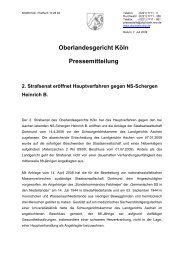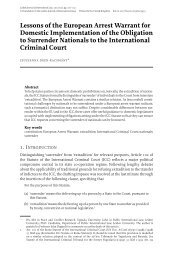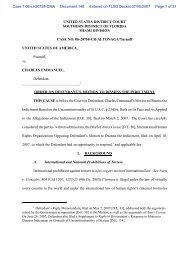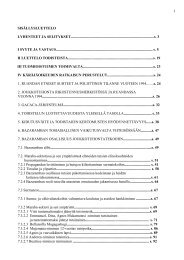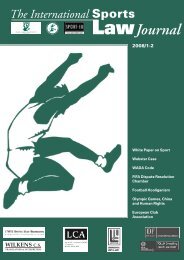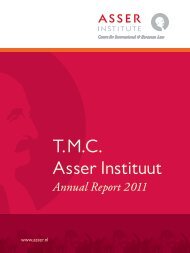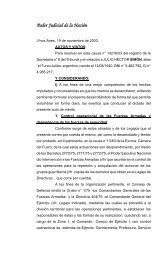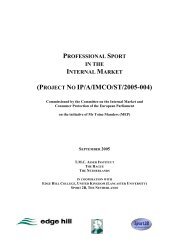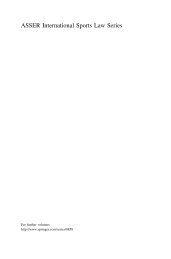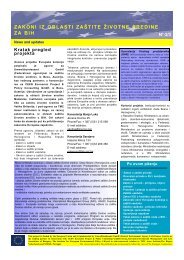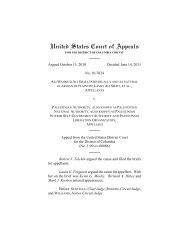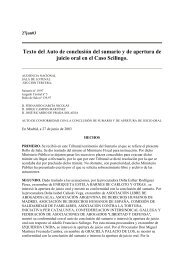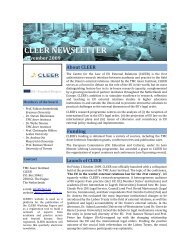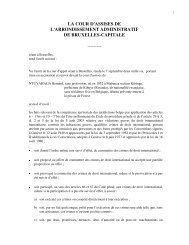Islj 2009 3-4 - TMC Asser Instituut
Islj 2009 3-4 - TMC Asser Instituut
Islj 2009 3-4 - TMC Asser Instituut
Create successful ePaper yourself
Turn your PDF publications into a flip-book with our unique Google optimized e-Paper software.
Community a new dimension, such as support for the disabled and<br />
the establishment of exchange and training programmes on a<br />
Community scale. 17 In its Helsinki Report on Sport, the Commission<br />
focussed on the reaffirmation and strengthening of the educational<br />
and social function of sport and the clarification of the legal environment<br />
of sport. 18 Moreover, the Commission considered itself as the<br />
defender of the European Sport Model.<br />
The 2007 White Paper on Sport covers three major themes: the societal<br />
role of sport, the economic dimension of sport, and the organisation<br />
of sport. 19 However, both the first and the third themes include<br />
a wide range of ‘sub-themes’. The Commission’s White Paper and its<br />
accompanying documents have two important merits. First, these<br />
documents, and in particular the background document, provide a<br />
correct summary of the application of EC law to sport. 20 Second, the<br />
listing of 53 actions in the Action Plan Pierre de Coubertin provided a<br />
clear indication of the Commission’s future plans in the field of<br />
sport. 21 Contrary to former policy statements, the Commission now<br />
sees itself (and the European Union) with a limited role. 22 This is<br />
illustrated by the repeated use of words like “support”, “facilitate”, or<br />
“promote”, by the lack of any concrete legislative proposals and by the<br />
fact that the Member States and the sports organisations are referred<br />
to as key players. It should also be noted that whereas the<br />
Commission still refers to the European sport model, it stipulates that<br />
“[…] it is unrealistic to try to define a unified model of organisation<br />
of sport in Europe”. 23<br />
Modest results<br />
The results of the direct EU sports policy are thus far rather limited.<br />
In practice, bringing topics on to the EU sports agenda often results<br />
in raising awareness, collecting information, and exchanging best<br />
practices. The ‘concrete outcome’ remains limited to the level of communications,<br />
conclusions, resolutions, reports or declarations. This to<br />
a certain extent reflects the fact that in the past rather vague or unrealistic<br />
goals, such as the preservation of the European Sport Model,<br />
have been put forward. However, even when more concrete targets<br />
were set, they seemed difficult to accomplish. In this regard, reference<br />
can be made to the Commission’s support plan to combat doping. 24<br />
In the aftermath of the 1998 ‘Festina Tour’ the Commission suggested<br />
a three-layer approach: to assemble the experts’ opinions on the<br />
ethical, legal and scientific dimensions of doping; to contribute to the<br />
creation of WADA; and to mobilise Community instruments and<br />
competences relevant to the field of doping. However, the realisation<br />
of this support plan and the development of a comprehensive EU<br />
anti-doping policy in general has proved to be rather troublesome. 25<br />
Nevertheless, the evolution towards a more coherent EU sports<br />
agenda, the establishment of working groups and the Commission’s<br />
new approach in its White Paper seem to have some positive effects.<br />
Whereas the implementation period of the Action Plan Pierre de<br />
Coubertin will continue till the end of the year 2012, it is too soon for<br />
a final evaluation. Yet, the regular drafting of implementation reports<br />
provides a useful overview of the progress made. In practice, reference<br />
can be made to the endorsement of Physical Activity Guidelines and<br />
the adoption by WADA’s Executive Committee of a revised<br />
International Standard following the EU Article 29 Data Protection<br />
Working Party on the World Anti-Doping Agency’s International<br />
Standard for the Protection of Privacy as notable results. 26 Moreover,<br />
the dialogue with the sports federations, in particular the IOC, was<br />
strengthened by initiatives such as the ‘reinvention’ of the European<br />
Sport Forum and the organisation of top-level meetings with the<br />
Olympic Movement. 27<br />
Legal framework and political will<br />
The absence of an express reference to sport in the EC Treaty has<br />
often been put forward as the key explanation for the limited outcome<br />
of the EU’s actions in the field of sport. Admittedly, the lack of<br />
a clear legal (and consequently also financial) basis had effects<br />
inevitably. 28 However, the absence of a ‘sports Article’ seems not the<br />
only reason for the modest results of the EU approach. In practice,<br />
lacking determination or political will seems to be another important<br />
factor. Again, the actions in the field of doping illustrate this. Even if<br />
this issue figured high on the political agenda, in the past, the<br />
Commission openly blamed the Council for failing to back it. 29 As<br />
Lenaerts flawlessly stated (in the field of education), this seeming contradiction<br />
between high level political declarations and the result in<br />
practice can be explained by the fact that “it makes a great difference<br />
to a Member State whether it gives its approval to a “resolution” or<br />
“conclusion”, or it adopts a measure which is going to form part of<br />
judicially enforcable Community law”. 30 Indeed, it is not because a<br />
specific legal basis in the field of sport is absent, that all (legal) action<br />
in the field of doping must be excluded. In reality, links can be found<br />
with public health, education, research, employment and social policy,<br />
and even the functioning of the Internal Market. 31<br />
It is against this background that the sport provisions in the Lisbon<br />
Treaty must be assessed.<br />
Article 165 of the Treaty on the Functioning of the European Union<br />
(TFEU) 32 stipulates the following on sport:<br />
“1.[…] The Union shall contribute to the promotion of European<br />
sporting issues, while taking account of the specific nature of sport,<br />
its structures based on voluntary activity and its social and educational<br />
function.<br />
2. Union action shall be aimed at:<br />
- developing the European dimension in sport, by promoting fairness<br />
and openness in sporting competitions and cooperation<br />
between bodies responsible for sports, and by protecting the physical<br />
and moral integrity of sportsmen and sportswomen, especially<br />
the youngest sportsmen and sportswomen.<br />
3. The Union and the Member States shall foster cooperation with<br />
third countries and the competent international organisations in<br />
the field of education and sport, in particular the Council of<br />
Europe. […]”<br />
The importance of these Treaty provisions lies principally in the fact<br />
that they help to create clarity in the so-called ‘legal environment of<br />
sport’. This insertion of sport in the formal framework of the Treaty<br />
turns it into an official Union policy. For the first time, the EU is<br />
17 Communication from the Commission<br />
to the Council and the European<br />
Parliament, The European Community<br />
and sport, SEC (91) 1438 final.<br />
18 Report from the Commission to the<br />
European Council with a view to safeguarding<br />
current sports structures and<br />
maintaining the social function of sport<br />
within the Community framework,<br />
COM (99) 644 final.<br />
19 European Commission, White Paper on<br />
Sport, COM (2007) 391 final.<br />
20 Communication from the Commission<br />
to the Council, the European Parliament,<br />
the Economic and Social Committee, and<br />
the Committee of the Regions,<br />
Community support plan to combat doping<br />
in sport, COM (1999) 643 final.<br />
21 Commission Staff Working Document,<br />
Action Plan “Pierre de Coubertin”, SEC<br />
(2007) 934.<br />
22 See Weatherill, The White Paper on<br />
Sport as an exercise in ‘Better regulation’,<br />
in Gardiner, Parrish and Siekmann (eds.)<br />
EU, Sport, Law and Policy. Regulation,<br />
re-regulation and representation (T.M.C.<br />
<strong>Asser</strong> Press, The Hague, <strong>2009</strong>), p. 101-<br />
114.<br />
23 White Paper on Sport, above n. 19, p. 12.<br />
24 Communication from the Commission<br />
to the Council, the European Parliament,<br />
the Economic and Social Committee and<br />
the Committee of the Regions,<br />
Community support plan to combat doping<br />
in sport, COM (1999) 643.<br />
25 See Vermeersch, ‘The European Union<br />
and the fight against doping in sport: on<br />
the field or on the sidelines?’, (2006)<br />
Entertainment and Sports Law Journal.<br />
26 Presidency’s Conclusions of the informal<br />
meeting of the ministers in charge of<br />
sport, Biarritz, 27-28 November 2008, p.<br />
1; World Anti-Doping Agency adopts<br />
revised data protection standard and continues<br />
successful dialogue with the EU,<br />
IP/09/733.<br />
27 Report from the EU Sport Forum, organised<br />
by the European Commission,<br />
Biarritz, 26-27 November 2008;<br />
Commission holds second high-level<br />
meeting with Olympic movement,<br />
IP/09/888. See in this respect also<br />
European Council Declaration on sport,<br />
Presidency conclusions, 11 and 12<br />
December 2008, annex 5.<br />
28 Van den Bogaert and Vermeersch, above<br />
n. 2, p. 823.<br />
29 Oral question by Athanasios Pafilis (H-<br />
0249/04), Deep dismay over the use of<br />
drugs at the Olympic Games.<br />
30 Lenaerts, ‘Education in the European<br />
Community law after Maastricht’, (1994)<br />
CML Rev., p. 7-41.<br />
31 Vermeersch, above n. 25<br />
32 Consolidated version of the Treaty on the<br />
Functioning of the European Union,<br />
[2008] OJ C 115/47.<br />
A RT I C L E S<br />
<strong>2009</strong>/3-4 5



